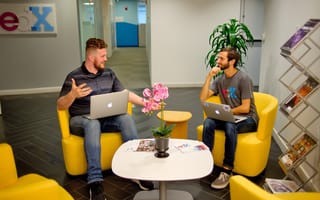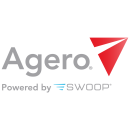It’s no secret that Boston’s tech scene moves at a quick pace. But it’s less obvious how today’s tech leaders keep one eye on the future at all times to stay ahead of industry trends. Lucky for you, we’ve tapped five of Boston’s top tech leaders to learn how they keep moving their industries forward — in lieu of a crystal ball.

Chief Product Officer Mark Haseltine stands at the helm of the online learning destination's latest innovations. Founded in 2012 by Harvard University and The Massachusetts Institute of Technology, edX offers online courses from top universities across the globe.
How has your company set itself apart as a leader in your industry? What tech innovations have helped you differentiate yourself?
EdX is the only nonprofit online learning platform and massive open online course (MOOC) provider that’s founded on a mission to bring high-quality education to people all over the world. We provide affordable access to courses and programs from the world’s top institutions that learners need to prepare for jobs of the future. The courses are delivered at scale where and when learners want to take them. We have over 20 million learners from all over the world! Many of our courses also stack into programs and credentials that learners can use to pursue their personal career goals, including our MicroMasters® programs.
In pursuing our mission, we’ve produced a number of important technical innovations. We have built the leading platform for scalable education delivery, which edX is built on. The open source platform, Open edX, is customizable and extensible in way that enables our partners to deliver quality courses with educational experiences that push the boundaries of how we learn online.
What do you think will be the next big tech trend in your industry, and how do you plan to stay ahead of that trend?
We are moving toward an area of mass personalization in online education. Specifically, using AI and machine learning to customize learning experiences that meet students where they are in terms of understanding material. Our delivery methods will need to take into account each learner’s prerequisite knowledge, gaps in skills and competencies, different learning delivery preferences, and desired curriculum and career pathways.
We are staying ahead of this trend by collaborating closely within our ecosystem to bring a steady stream of innovations to our courses and programs. We are fortunate to have a large, engaged, worldwide community who are committed to advancing mass personalization. At edX, we work together to continually experiment with new solutions, determine what works, and drive proven ideas across our catalog.

Leif Jentoft is the co-founder of RightHand Robotics, a company speeding up the supply chain with easy-to-use robotics. Born out of a higher education trifecta, Harvard Biorobotics Lab, the Yale Grab Lab, and MIT, RightHand Robotics provides end-to-end solutions that ultimately lower e-commerce fulfillment costs in industries like grocery, apparel and electronics.
How has your company set itself apart as a leader in your industry? What tech innovations have helped you differentiate yourself?
There are a number of unique attributes to our solutions, including our gripper designs that utilize suction and finger grasping; physical features that simplify swapping out hardware; and even advanced algorithms that deliver exceptional performance as measured by the 3Rs (range, rate, and reliability). Most importantly, it’s how these elements are combined with others to solve our customers’ problem — how to succeed in the era of “piece” demand — and provide compelling return on investment.
RightPick leverages best in class commercial components, meaning we do not have to develop new robotic arms or invent an entirely new camera. By making this system design choice, we can incorporate new hardware when it becomes available. We apply the same continuous improvement design philosophy to software. Combined with the machine learning capability RightPick uses to leverage its massive piece-picking data set, RightPick is a system that will continuously improve over time.
What do you think will be the next big tech trend in your industry, and how do you plan to stay ahead of that trend?
The pace of supply chain has rapidly accelerated. A warehouse that is heavily optimized to leverage 20-year predictions is less efficient over its lifetime compared to flexible design that's responsive to changing business needs.
For supply chain practitioners, it's all about how to adopt automation to effectively deal with shifts in customer demands for on-demand delivery of each product. This means that there will be opportunities for robotic systems due to a massive global trend toward supply chain digitization. We've conceived RightPick, an autonomous robotic piece-picking system, to flexibly evolve to address the needs for a broad range of basic warehouse tasks. We believe this capability will open up new opportunities for the retailers and distributors leading the way in implementation of new systems that drive exceptional customer experience.

Touchplan Vice President of Customer Experience Dave Rolin plays an instrumental role in helping the company deliver real-time construction management tools — think Google Docs for construction. Touchplan helps construction projects run smoothly by reducing project time, improving communication, and ensuring smooth sailing for users.
How has your company set itself apart as a leader in your industry? What tech innovations have helped you differentiate yourself?
From day one, we’ve been a real-time, collaborative tool targeted to the entire construction team. We’ve worked really hard to have these be the differentiators that allow users to see exactly what’s happening in real-time regardless of where they’re located. As an organization, we’ve identified these two components to be the source of the best outcomes for our customers. A lot of our competitors are legacy tools that had to adhere to previous applications that don’t have those capabilities as a core focus.
The real-time collaboration is a definite innovation. We were like the Google Docs for construction long before anyone else. We also intentionally focused our efforts on computing meaningful dates for project teams based on the schedules they create. Teams can input a high-level plan with little detail and Touchplan seamlessly transforms that information into specific dates to help with plans and improve decision-making. Because of all the information and detail involved, simplicity in data visualization is key. The simplistic look from our design and development team sets us apart. Finally, since there’s no legacy application to maintain; we have the flexibility to use all modern tools ensuring that Touchplan is cloud-based and mobile-first while using both SQL and noSQL databases.
What do you think will be the next big tech trend in your industry, and how do you plan to stay ahead of that trend?
As most tech has become cloud-based, there’s more demand for open APIs to allow multiple tools to seamlessly work together. We are staying ahead by integrating and working with other popular solutions that our customers use. With those integrations, we aim to give customers deeper data in their dashboards in order to improve insight— driving and shaping better behavior from past experiences.
We also see more and more ‘goal-oriented’ techniques in areas like fitness apps that drive these behaviors, and we have the data to prove it. What’s really interesting is figuring out the motivation to drive these behaviors and how the software that we create makes that happen.
Marie Cuddy is the principal software engineer at Plastiq, a bill pay provider that allows consumers and business owners to use a credit card for nearly any expense under the sun. The company has signed up more than a million clients, helping users make the most of their payments by raking in credit card rewards and maximizing early payment discounts.
How has your company set itself apart as a leader in your industry? What tech innovations have helped you differentiate yourself?
Plastiq enables customers to pay anyone on their credit card. The company transforms card payments into a form of payment that the recipient already accepts — not requiring the recipient to sign up to accept. All other players in our space (think PayPal, Square, etc.) require the recipient to be signed up before they accept payments. From CI/CD and machine learning to content acceleration, we have used many innovations to gain a competitive edge and maximize our speed of delivery and the quality of our product.
What do you think will be the next big tech trend in your industry, and how do you plan to stay ahead of that trend?
One trend we are embracing is the use of the same programming languages on multiple parts of our stack. We are rewriting core parts of our back end, which were in PHP and Java into node.js. The change is improving engineers productivity, cutting down on context switching and allows engineers, who were traditionally front end only, to work on all parts of our stack.

Raj Behara is the vice president and chief technology officer of driving assistance services provider Agero. The company is on a mission to protect consumers on the road with platform intelligence and their team-powered solutions.
How has your company set itself apart as a leader in your industry? What tech innovations have helped you differentiate yourself?
Agero, which protects more consumers in the U.S. (over 115 million) than any other white-label roadside assistance provider, continues to lead the transformation and growth of the roadside industry, pioneering digital, on-demand roadside assistance. We introduced the first full-feedback, closed-loop notification process using interactive voice response and text notification solutions, in addition to an industry-first service provider digital tracking capability at scale. Today, in addition to our award winning contact center service capabilities, we are providing an end-to-end digital and transparent service flow for consumers, service providers and our clients. The service flow includes digital request and communication channels such as mobile APIs, auto-dispatch capabilities, machine learning-based event monitoring, and real-time dashboarding.
We are also leveraging data from over 12 million annual roadside and accident events across 350 metros, combined with over 200 million service provider miles and other proprietary data, to explore new intelligent service provider selection processes for vehicle disablements.
What do you think will be the next big tech trend in your industry, and how do you plan to stay ahead of that trend?
The use of real-time engagement platforms with digital communication channels will continue to revolutionize the roadside assistance industry, especially from a service provider perspective. Over-the-phone tow and roadside dispatches continue to be the channel of choice for a significant portion of the provider market. However, Agero is driving adoption of the digital and mobile technologies that consumers rely on within the provider space on a massive scale to deliver real-time experiences to the drivers covered by our over 100 client programs.
As part of this, integrated texting capabilities within mobile APIs will continue to grow, enabling new use cases that introduce new automation capabilities with digital assistant integrations. Similarly, messaging apps will transform services into conversational experiences, fundamentally shifting how consumers request and stay up to date on services. Agero continues to invest in this space, with integrations currently in use and others ramping up rapidly.







